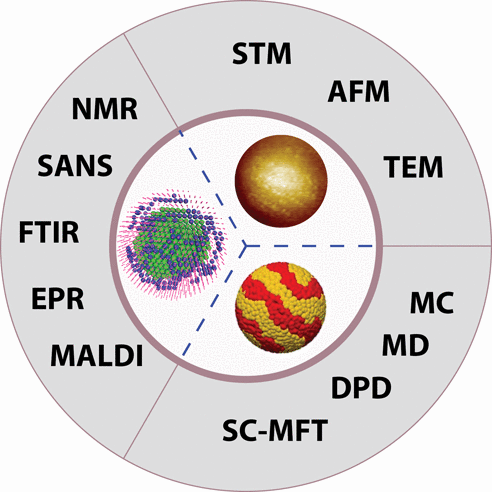当前位置:
X-MOL 学术
›
Acc. Chem. Res.
›
论文详情
Our official English website, www.x-mol.net, welcomes your feedback! (Note: you will need to create a separate account there.)
Characterization of Ligand Shell for Mixed-Ligand Coated Gold Nanoparticles
Accounts of Chemical Research ( IF 18.3 ) Pub Date : 2017-08-03 00:00:00 , DOI: 10.1021/acs.accounts.7b00165 Quy Ong 1 , Zhi Luo 1 , Francesco Stellacci 1
Accounts of Chemical Research ( IF 18.3 ) Pub Date : 2017-08-03 00:00:00 , DOI: 10.1021/acs.accounts.7b00165 Quy Ong 1 , Zhi Luo 1 , Francesco Stellacci 1
Affiliation

|
Gold nanoparticles owe a large number of their properties to their ligand shell. Indeed, many researchers routinely use mixtures of ligand molecules for their nanoparticles to impart complex property sets. It has been shown that the morphology of ligand shells (e.g., Janus, random, stripelike) leads to specific properties. Examples include wettability, solubility, protein nonspecific adsorption, cell penetration, catalysis, and cation-capturing abilities. Yet, it remains a great challenge to evaluate such morphologies in even the most fundamental terms such as dimension and shape. In this Account, we review recent progress in characterization techniques applicable to gold nanoparticles with ligand shells composed of mixed ligands. We divide the characterization into three major categories, namely, microscopy, spectroscopy, and simulation. In microscopy, we review progresses in scanning tunneling microscopy (STM), atomic force microscopy (AFM), and scanning/transmission electron microscopy. In spectroscopy, we mainly highlight recent achievements in nuclear magnetic resonance (NMR), mass spectrometry (MS), small angle neutron scattering (SANS), electron spin resonance (EPR), and adsorption based spectroscopies. In simulation, we point out the latest results in understanding thermodynamic stability of ligand shell morphology and emphasize the role of computer simulation for helping interpretation of experimental data. We conclude with a perspective of future development.
中文翻译:

配体包覆的金纳米粒子的配体壳的表征
金纳米颗粒由于其配体壳而具有许多特性。实际上,许多研究人员通常将配体分子的混合物用于其纳米颗粒,以赋予复杂的性能集。已经表明,配体壳的形态(例如,Janus,无规,条状)导致特定的性质。实例包括润湿性,溶解性,蛋白质非特异性吸附,细胞渗透,催化和阳离子捕获能力。然而,即使以最基本的术语(例如尺寸和形状)来评估这种形态,仍然是一个巨大的挑战。在本报告中,我们回顾了表征技术的最新进展,该技术适用于具有由混合配体组成的配体壳的金纳米颗粒。我们将表征分为三大类,即显微镜,光谱学和模拟。在显微镜下,我们回顾了扫描隧道显微镜(STM),原子力显微镜(AFM)和扫描/透射电子显微镜的进展。在光谱学中,我们主要强调核磁共振(NMR),质谱(MS),小角中子散射(SANS),电子自旋共振(EPR)和基于吸附的光谱学的最新成就。在模拟中,我们指出了了解配体壳形态热力学稳定性的最新结果,并强调了计算机模拟在帮助解释实验数据中的作用。我们以对未来发展的看法作为结束。我们主要强调核磁共振(NMR),质谱(MS),小角中子散射(SANS),电子自旋共振(EPR)和基于吸附的光谱学的最新成就。在模拟中,我们指出了了解配体壳形态热力学稳定性的最新结果,并强调了计算机模拟在帮助解释实验数据中的作用。我们以对未来发展的看法作为结束。我们主要强调核磁共振(NMR),质谱(MS),小角中子散射(SANS),电子自旋共振(EPR)和基于吸附的光谱学的最新成就。在模拟中,我们指出了了解配体壳形态热力学稳定性的最新结果,并强调了计算机模拟在帮助解释实验数据中的作用。我们以对未来发展的看法作为结束。
更新日期:2017-08-03
中文翻译:

配体包覆的金纳米粒子的配体壳的表征
金纳米颗粒由于其配体壳而具有许多特性。实际上,许多研究人员通常将配体分子的混合物用于其纳米颗粒,以赋予复杂的性能集。已经表明,配体壳的形态(例如,Janus,无规,条状)导致特定的性质。实例包括润湿性,溶解性,蛋白质非特异性吸附,细胞渗透,催化和阳离子捕获能力。然而,即使以最基本的术语(例如尺寸和形状)来评估这种形态,仍然是一个巨大的挑战。在本报告中,我们回顾了表征技术的最新进展,该技术适用于具有由混合配体组成的配体壳的金纳米颗粒。我们将表征分为三大类,即显微镜,光谱学和模拟。在显微镜下,我们回顾了扫描隧道显微镜(STM),原子力显微镜(AFM)和扫描/透射电子显微镜的进展。在光谱学中,我们主要强调核磁共振(NMR),质谱(MS),小角中子散射(SANS),电子自旋共振(EPR)和基于吸附的光谱学的最新成就。在模拟中,我们指出了了解配体壳形态热力学稳定性的最新结果,并强调了计算机模拟在帮助解释实验数据中的作用。我们以对未来发展的看法作为结束。我们主要强调核磁共振(NMR),质谱(MS),小角中子散射(SANS),电子自旋共振(EPR)和基于吸附的光谱学的最新成就。在模拟中,我们指出了了解配体壳形态热力学稳定性的最新结果,并强调了计算机模拟在帮助解释实验数据中的作用。我们以对未来发展的看法作为结束。我们主要强调核磁共振(NMR),质谱(MS),小角中子散射(SANS),电子自旋共振(EPR)和基于吸附的光谱学的最新成就。在模拟中,我们指出了了解配体壳形态热力学稳定性的最新结果,并强调了计算机模拟在帮助解释实验数据中的作用。我们以对未来发展的看法作为结束。



























 京公网安备 11010802027423号
京公网安备 11010802027423号